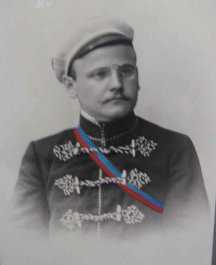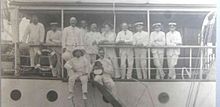Ernst Sarfert

Ernst Gotthilf Sarfert (born November 4, 1882 in Schönau near Zwickau , † November 19, 1937 in Leipzig ) was a German ethnologist and explorer .
Life
Ernst Sarfert was the youngest son of twelve children of the innkeeper couple Christian Gotthilf and Ernestine Pauline Sarfert. One of his brothers was William Sarfert, director of the Sachsenwerke in Dresden .
After attending the public school and the secondary school in Zwickau, Sarfert studied German , history and geography at the universities in Jena and Leipzig . During his studies he became a member of the gymnastics club Normannia Jena , for which he fought several courses . At the suggestion of his teacher Karl Weule , at the end of his studies he devoted himself more to ethnology and received his doctorate in 1908 with a dissertation House and Village among the natives of North America . Since 1907 a trainee at the Museum für Völkerkunde zu Leipzig , he represented his research institution as a scientific assistant at the International Americanist Congress in Vienna in 1908 . At the same time karl weule struck him as a participant of the South Sea Expedition of the Hamburg Scientific Foundation before that of Georg Thilenius was organized in the period from 1908 to 1910 several scientists with the chartered research vessel Peiho to Melanesia and Micronesia led.
Sarfert was only able to join this expedition from Hong Kong in 1909 . For his studies he stayed for a long time on the islands of Sorol , Ifalik , Satawal , Puluwat and Kusae . Even after the expedition officially ended, he continued his research on Kusae for almost three months longer.
After his return, he worked as head of the Indonesian-Oceanic Department of the Leipzig Ethnological Museum, mainly on the systematization of his exhibits and records. His manuscript on Kusae (now Kosrae), published in 1919 and 1920, was already ready for printing in 1913. The evaluation of his research, its publication and the work in the Leipzig collections was interrupted by the outbreak of the First World War, in which Sarfert participated as a front soldier and later as a lieutenant in the air defense.
With the loss of the German colonies at the end of the First World War, he saw his career as an ethnologist over and left the Museum of Ethnology voluntarily. With his support, the processing of his field research records was subsequently taken over by Hans Damm, who later became the director of the Leipzig Ethnographic Museum. In 1929 and 1931 - also in the series of the Hamburg Scientific Foundation and with the support of the Notgemeinschaft der Deutschen Wissenschaft (today DFG ) - the two half-volumes of the book Luangiua and Nukumanu were printed. Another volume based on Sarfert's notes, edited by Hans Damm, appeared in 1935 as the second half volume of islands around Truk ( Central Carolines East) : Polowat, Hok and Satowal . In 1938, after Sarfert's death, the 2nd half volume appeared on the Central Carolines . Sarfert's research still represents unique source material and is of inestimable value for the inhabitants of the islands to document their culture. Translations of the volumes into English, albeit still unpublished, are at the instigation of Francis X. Hezel in the Micronesian seminar on Pohnpei .
After completing his scientific career, Ernst Sarfert devoted himself to the sale of radio equipment as an independent businessman. From 1929 he worked as a representative and authorized signatory for various companies. He died as a result of gastric surgery and was buried in the Südfriedhof in Leipzig.
Ernst Sarfert married Emma Rohland on October 8, 1917 in Leipzig-Gohlis. The daughters Edith and Anita came from the marriage.
Works (selection)
- House and village with the natives of North America , dissertation, F. Vieweg and Son, Braunschweig 1908 ( online )
- To the knowledge of the navigation of the Carolinians , F. Vieweg and Son, Braunschweig 1911
- Luangiua and Nukumanu. Based on the notes of Ernst Sarfert. by Hans Damm , half vol. 1: general part and material culture ; Half vol. 2: Social conditions and intellectual culture Hamburg 1929–1935 (results of the South Sea expedition 1908–1910, 2, B, vol. 12)
- Kusae , Results of the South Seas Expedition, 1908–1910 Ethnography, Micronesia, Volume 4
literature
- The Sarfert letters. News for the Sarfert family , 22nd edition, May 2008
- Andreas Leipold: The first year of the Hamburg South Sea Expedition in German New Guinea (1908-1909) , BoD, Norderstedt 2008, ISBN 978-3-86741-059-5
- Georg Thilenius (Hrsg.), Otto Reche (Hrsg.): Results of the South Sea Expedition 1908 - 1910. Published on behalf of the Hamburg Museum of Ethnology and Prehistory , Hamburg 1927ff
- Hans Damm (ed.), Augustin Krämer (ed.): Zentralkarolinen , 2nd half volume: Ifaluk-Aurepik-Faraulip-Sorol-Mogemog. According to the records of Prof. Dr. Hambruch and Dr. E. Sarfert , Hamburg 1938 (Results of the South Seas Expedition 1908-1910, 2, B, Vol. 10)
Individual evidence
| personal data | |
|---|---|
| SURNAME | Sarfert, Ernst |
| ALTERNATIVE NAMES | Sarfert, Ernst Gotthilf (full name) |
| BRIEF DESCRIPTION | German ethnologist and researcher |
| DATE OF BIRTH | November 4, 1882 |
| PLACE OF BIRTH | Schönau near Zwickau |
| DATE OF DEATH | November 19, 1937 |
| Place of death | Leipzig |

